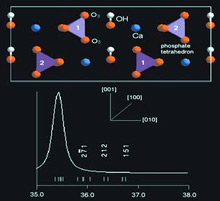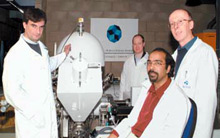| 2005 |

|
YEAR BOOK |
University of Limerick
|
MSSI Scientists make important breakthrough in bone implant science
|

The exciting aspect of this new structure is that it predicts that hydroxyapatite could generate an electrical charge when it is mechanically stressed, a property termed piezoelectricity. Piezoelectricity has been a known property of natural bone for many years, and it is considered one of the driving mechanisms by which bones grow and bond together. Aside from the fact that the discovery redefines hydroxyapatite as a smart material, i.e. one that responds to environmental changes, this is of potentially huge significance in terms of developing new bone implant structures that utilise this piezoelectric potential and are thus much more bioactive and biocompatible.
The MSSI team, using facilities funded under the Programme for Research in Third Level Institutions, carried out quantum mechanical simulations of the crystal structure and thermal stability of hydroxyapatite. By focussing on the significance of weak, poorly explained peaks in the X-ray diffraction pattern of hydroxyapatite, the team was able to show that the established structure was incorrect and proposed a new correct crystal structure for this material. This new structure predicts that the material will have piezoelectric properties, whereas the older, previously accepted structures for hydroxyapatite did not.
With an estimated �2.1 billion global market for bone and dental implants, this sector of the healthcare and biomedical industry is obviously important to the Irish economy. This work is a good example of how government investment in basic scientific research can have the potential to develop new products with a distinct competitive edge.

|
|
Contact: Dr Syed Tofail, MSSI, University of Limerick; Tel. +353-61-213127;
Email: [email protected]
Dr Seamus McMonagle, MSSI, University of Limerick; Tel. +353-61-202068;
Email: [email protected]